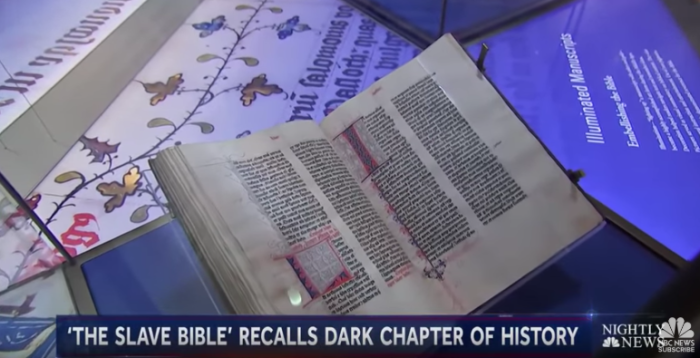'Slave Bible' on display at Museum of the Bible; edition removes chapters to uphold slavery

Although the Bible is filled with scriptures of freedom and Jesus preached in Luke 4:8 that He came to “set the captives free,” the holy book was once altered to convey the exact opposite message as a way to enforce slavery.
The controversial “Slave Bible,” published in 1807 in London, is currently on display at the Museum of the Bible in Washington, D.C., and while it looks like any other Bible on the outside, its pages are meant to push an inhumane agenda by selectively removing almost 90 percent of the Old Testament and 50 percent of the New Testament, as described by Museum of the Bible curator Anthony Schmidt.
“A normal King James Version has 1189 chapters in it, the slave bible has only 282,” Schmidt told NBC news.
The distorted translation is missing the Old Testament chapter of Exodus which features the famous Moses account when he demands Pharaoh to set the Israelites free from captivity in Egypt and God makes a way for them to leave.
The book of Jeremiah was also removed because of verses such as, “Woe to him who builds his palace by unrighteousness, his upper rooms by injustice, making his own people work for nothing, not paying them for their labor” (Jeremiah 22:13).
The slave version likewise discarded the New Testament book of Galatians where the apostle Paul specifically destroys the idea that some people are greater than others. “There is neither Jew nor Gentile, neither slave nor free, nor is there male and female, for you are all one in Christ Jesus” (Galatian 3:28).
What can be found in the book are passages such as Ephesians 6:5, which reads, “Slaves, obey your earthly masters with respect and fear, and with sincerity of heart, just as you would obey Christ.”
The Gospel Coalition says practices like slavery, polygamy, and divorce were common in antiquity but clarifies that biblical instruction which “allows for them in certain contexts isn’t necessarily biblical approval.” As most Christians would agree, the Bible is to be interpreted in the full counsel of Scripture and not just at some moments of history.
Museum President and CEO Ken McKenzie said he’s hoping the “Slave Bible” exhibit will discourage something like this from “ever happening again.”
“The Bible itself is a whole book; it’s not one that you get to carve up and you get to use this piece or that piece,” McKenzie told NBC.
The “Slave Bible” was formally named “Parts of the Holy Bible Selected for the Use of the Negro Slaves in the British West-India Islands.” Schmidt revealed that they believe it was likely produced by a missionary organization known as “The Society for the Conversion of the Negro Slaves.”
The missionaries, though many were abolitionists, were reportedly under the impression that the revised Scriptures “would improve the lives of enslaved Africans both materially and spiritually.”
“This book,” Schmidt explained, “is aimed at justifying and reinforcing the slave system. But at the same time, it was used to help teach Africans how to read, for example, and to somehow educate them in the classroom.”
The exhibition was open November 2018 and will be on display until September 2019 at the Museum of the Bible. Vistors are encouraged to join the ongoing conversation about the "Slave Bible" in the exhibition’s response area.



























